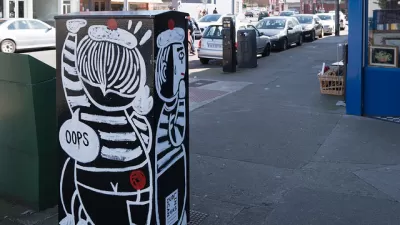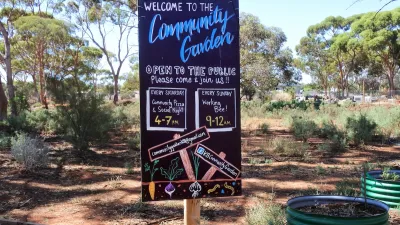Cities around the country have been making it easier to decorate mundane utility boxes into something more colorful and representative of the neighborhoods they serve.
Bill Lindeke writes that in a few Minneapolis neighborhoods, utility boxes "have flowered into some of the best showcases for public art, bringing community together in often surprising ways."
Lindeke explains some of the benefits of turning utility boxes into colorful centerpieces for the street, including graffiti reduction and a more creative streetscape.
The article also detail process—both from the standpoint of the vinyl wrap technology that enables all kinds of artistic representation on to the boxes and the approvals necessary to undertake such a makeover. Lindeke describes that process as cumbersome, despite the city's recent adoption of pre-approved designs to streamline the process.
Of course, pre-approved designs also defeat the purpose of one of the benefits of such art projects, as described by Lindeke: "The public-space utility of utility boxes is an unexpected urban dynamic. What first appears to be the epitome of boring infrastructural blight, when given a little bit of artistic love, can become one of the small ways that people begin to make meaning in their neighborhood."
FULL STORY: The flowering of utility boxes: Turning mysterious infrastructure into public art

Trump Administration Could Effectively End Housing Voucher Program
Federal officials are eyeing major cuts to the Section 8 program that helps millions of low-income households pay rent.

Planetizen Federal Action Tracker
A weekly monitor of how Trump’s orders and actions are impacting planners and planning in America.

Ken Jennings Launches Transit Web Series
The Jeopardy champ wants you to ride public transit.

Washington Legislature Passes Rent Increase Cap
A bill that caps rent increases at 7 percent plus inflation is headed to the governor’s desk.

From Planning to Action: How LA County Is Rethinking Climate Resilience
Chief Sustainability Officer Rita Kampalath outlines the County’s shift from planning to implementation in its climate resilience efforts, emphasizing cross-departmental coordination, updated recovery strategies, and the need for flexible funding.

New Mexico Aging Department Commits to Helping Seniors Age ‘In Place’ and ‘Autonomously’ in New Draft Plan
As New Mexico’s population of seniors continues to grow, the state’s aging department is proposing expanded initiatives to help seniors maintain their autonomy while also supporting family caregivers.
Urban Design for Planners 1: Software Tools
This six-course series explores essential urban design concepts using open source software and equips planners with the tools they need to participate fully in the urban design process.
Planning for Universal Design
Learn the tools for implementing Universal Design in planning regulations.
Heyer Gruel & Associates PA
Ada County Highway District
Institute for Housing and Urban Development Studies (IHS)
City of Grandview
Harvard GSD Executive Education
Toledo-Lucas County Plan Commissions
Salt Lake City
NYU Wagner Graduate School of Public Service




























